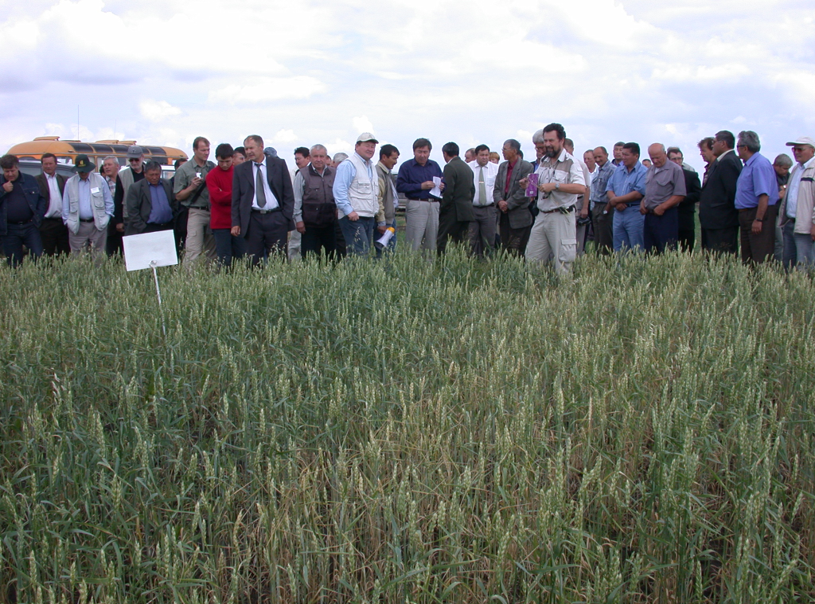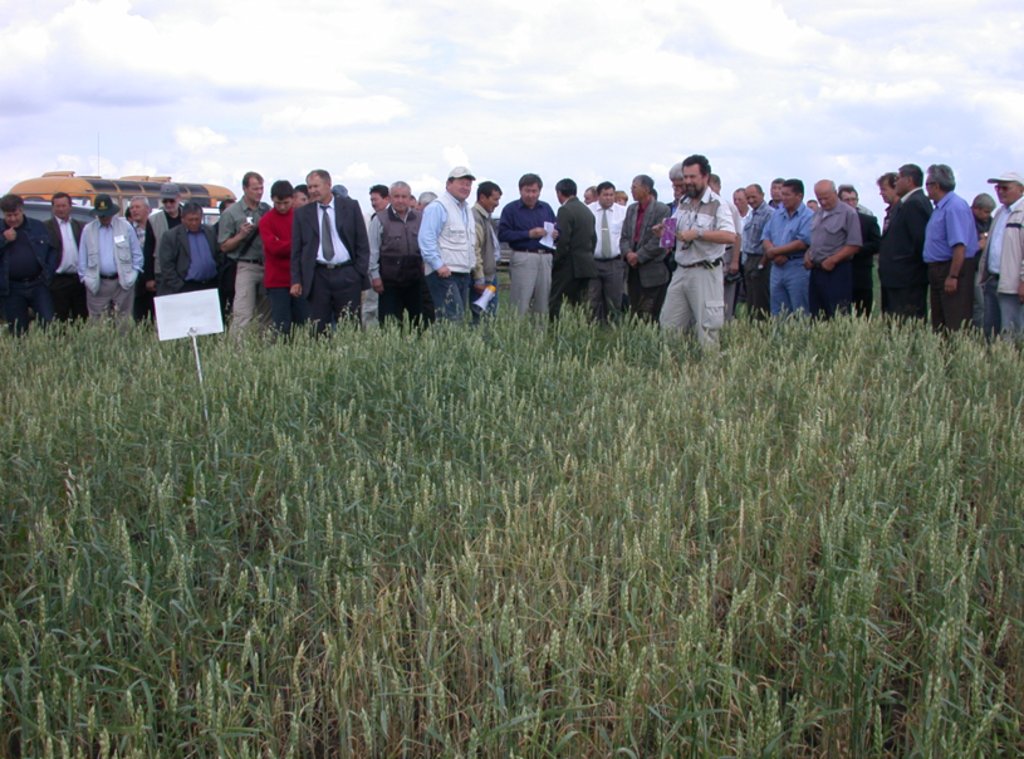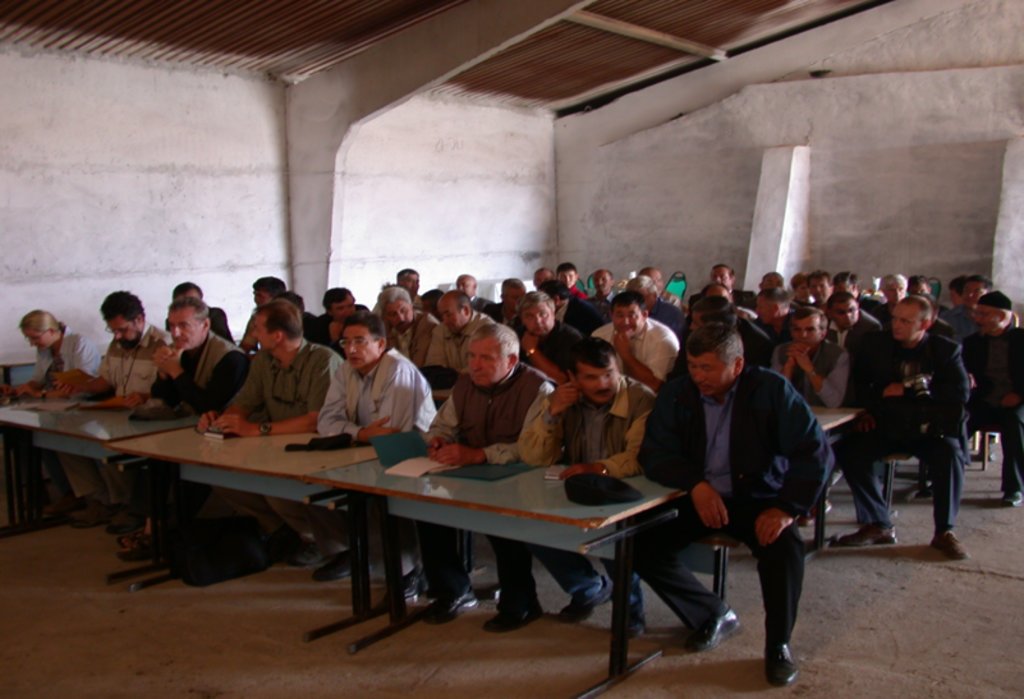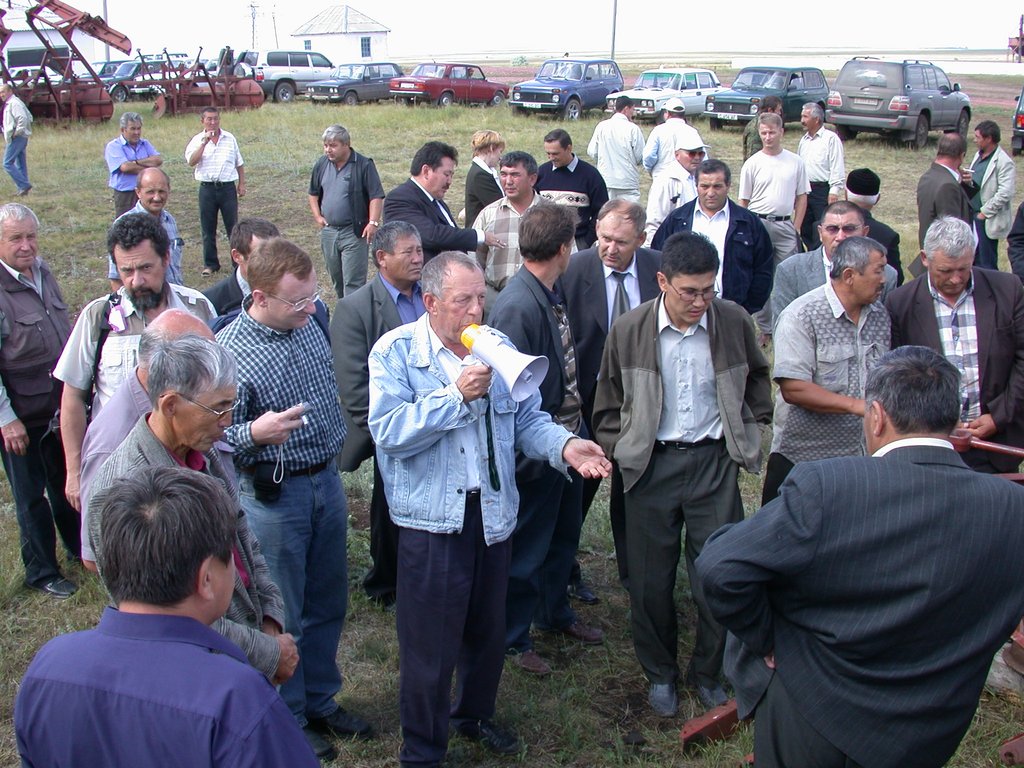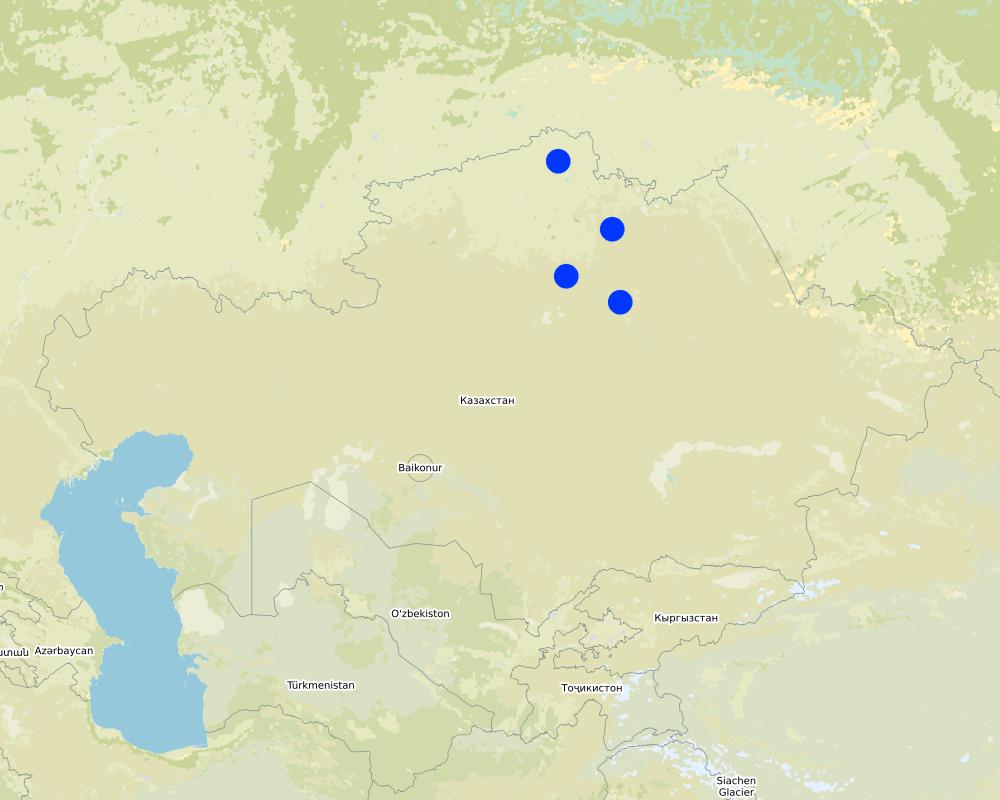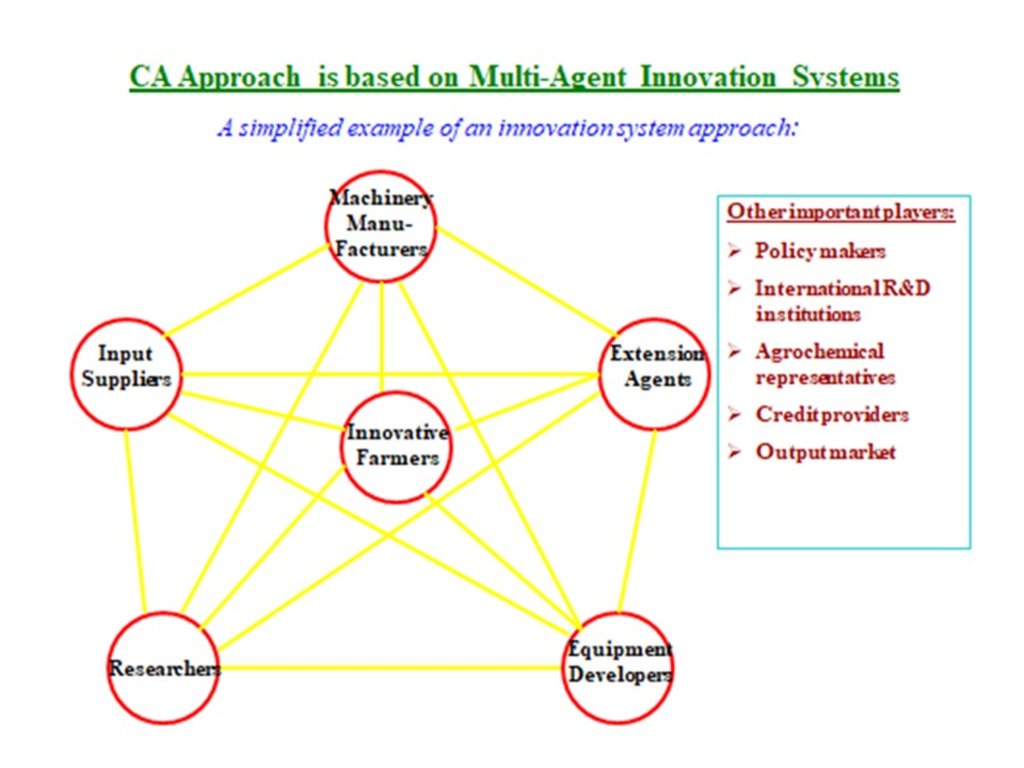Awareness Raising for SLM Using Conservation Agriculture [ប្រទេសកាហ្សាក់ស្ថាន]
- ការបង្កើត៖
- បច្ចុប្បន្នភាព
- អ្នកចងក្រង៖ Kulyash Iskandarova
- អ្នកកែសម្រួល៖ –
- អ្នកត្រួតពិនិត្យ Rima Mekdaschi Studer
Awareness and knowledge on Conservation Agriculture for rainfed crop production
approaches_5677 - ប្រទេសកាហ្សាក់ស្ថាន
ពិនិត្យមើលគ្រប់ផ្នែក
ពង្រីកមើលទាំងអស់ បង្រួមទាំងអស់1. ព័ត៌មានទូទៅ
1.2 ព័ត៌មានលម្អិតពីបុគ្គលសំខាន់ៗ និងស្ថាប័នដែលចូលរួមក្នុងការវាយតម្លៃ និងចងក្រងឯកសារនៃវិធីសាស្ត្រផ្សព្វផ្សាយ
បុគ្គលសំខាន់ម្នាក់ (ច្រើននាក់)
expert/consultant:
Karabayev Muratbek
+7 (7172) 34 37 13 / +7 (701) 216-77-21
m.karabayev@cgiar.org / muratbek.karabayev@gmail.com
International Maize and Wheat Improvement Center (CIMMYT), CIMMYT-Kazakhstan
Office #7, B.Maylin str., 10, Astana, 010000, Kazakhstan
ប្រទេសកាហ្សាក់ស្ថាន
ឈ្មោះគម្រោងដែលបានចងក្រងឯកសារ/ វាយតម្លៃលើវិធីសាស្ត្រផ្សព្វផ្សាយ (បើទាក់ទង)
Integrated natural resources management in drought-prone and salt-affected agricultural production landscapes in Central Asia and Turkey ((CACILM-2))ឈ្មោះអង្គភាពមួយ (ច្រើន) ដែលបានចងក្រងឯកសារ/ វាយតម្លៃលើវិធីសាស្ត្រផ្សព្វផ្សាយ (បើទាក់ទង)
Kazakh Research Institute for Livestock and Fodder Production (Kazakh Research Institute for Livestock and Fodder Production) - ប្រទេសកាហ្សាក់ស្ថាន1.3 លក្ខខណ្ឌទាក់ទងទៅនឹងការប្រើប្រាស់ទិន្នន័យដែលបានចងក្រងតាមរយៈវ៉ូខេត
តើពេលណាដែលទិន្នន័យបានចងក្រង (នៅទីវាល)?
02/02/2020
អ្នកចងក្រង និង(បុគ្គលសំខាន់ៗ)យល់ព្រមទទួលយកនូវលក្ខខណ្ឌនានាទាក់ទងទៅនឹងការប្រើប្រាស់ទិន្នន័យដែលបានចងក្រងតាមរយៈ វ៉ូខេត:
បាទ/ចា៎
1.4 ការយោងមួយ (ច្រើន) ទៅលើ (កម្រង) បញ្ជីសំណួរនៃបច្ចេកទេស SLM
2. ការពណ៌នាអំពីវិធីសាស្ត្រផ្សព្វផ្សាយ SLM
2.1 ពណ៌នាសង្ខេបខ្លីពីវិធីសាស្ត្រផ្សព្វផ្សាយ
Raising awareness and strengthening the capability and skills of farmers, agriculture specialists and researchers in developing and adoption resource-saving, profitable and environmentally friendly cereal production through Conservation Agriculture practices.
2.2 ពណ៌នាលម្អិតពិវិធីសាស្ត្រផ្សព្វផ្សាយ
ពណ៌នាលម្អិតពិវិធីសាស្ត្រផ្សព្វផ្សាយ:
The main features of the approach:
•Empower farmers to become self-sufficient in managing their lands under Conservation Agriculture through education, awareness raising with a focus on transferring knowledge, skills and tools to improve crop production, increase food security, and incomes of rural communities.
•Promote the transition from traditional farming to modern systems based on minimal soil treatment, diversified crop production, stubble retention and direct seeding by building capacity.
•Facilitate positive change by leveraging the strengths and capabilities of different partners to transfer skills, knowledge and resources to farmers and communities interested in active CA adoption.
In Kazakhstan the most of crop management experiences and education in universities emphasized conventional tillage based production systems. Changing minds to accept crop management practices based on the principles of Conservation Agriculture is one of the biggest constraint of CA adoption. Farmers are ready to change their mind set if they are knowledgeable, well informed and see the benefits of CA-based crop management practices in their fields. The approach is based on awareness raising, training of farmers and farmer testing of CA technology in close collaboration with specialists from international and local institutions. An active dialogue with farmers, knowledge and technology dissemination are built on participation of qualified specialists/experts who are part of the management team of each farm and are able to efficiently test and adapt new technologies to the local conditions. CA is a complex approach and system, it implies changes in a number of technological components of the existing traditional systems of agriculture. It is necessary to change two basic paradigms: the paradigm of soil tillage and the paradigm of linear knowledge flow.
Many agricultural research and extension systems are based on a linear model of knowledge flow, with new knowledge being developed in research organizations, passed on to agricultural extension agents who in turn pass on the new knowledge and information to farmers. While this model may be applied to simple technology, it does not always effectively work with complex technologies, especially when research institutes do not have the capacity to develop functional packages of multiple technological components for all farmer situations. Innovative approaches on the basis of complex technologies are needed in adaptation, system development process and promotion. Innovative approach (platforms) are based on networks of multiple agents, including farmers-innovators and decision-makers, all utilizing their own knowledge, external information and policy support to help overcome problems and develop functional systems for local farming conditions and farmer circumstances.
The target farmers as well as farmers of the neighbouring farming community were trained on-the-job on key topics of CA such as diversified cropping systems, chemical fallow, minimum/no-tillage, direct seeding, and snow and residue management. Altogether four training workshops were carried out. In each session international and national experts trained about 30 farmers. Conservation Agriculture study tour to USA (Washington State, Idaho State) and Canada (Saskatchewan Province) was organized. Public awareness and also training on CA-technology also were generated through six field days and seminars bringing together farmers, stakeholders, policy-makers and researchers to observe and discuss key field demonstrations.
Large-scale adoption of Conservation Agriculture (zero/minimum soil tillage, leaving crop residues in the fields, direct seeding with narrow chisel and disk openers, permanent bed-planting and furrow irrigation, etc.) were initiated by the International Maize and Wheat Improvement Center (CIMMYT) and FAO in 2002. Thanks to the joint efforts of national scientists and farmers, international organizations (CIMMYT, FAO, ICARDA, World Bank, UNDP, USAID, etc.), support by the state and government bodies, the areas under no-till have been increasing from virtually none in 2002 to an estimated area of 3 000 000 ha in 2019.
2.3 រូបភាពនៃវិធីសាស្ត្រផ្សព្វផ្សាយ
2.4 វីឌីអូនៃវិធីសាស្ត្រផ្សព្វផ្សាយ
ការពណ៌នាសង្ខេប:
Not available
2.5 ប្រទេស/តំបន់/ទីតាំងកន្លែង ដែលវិធីសាស្ត្រផ្សព្វផ្សាយត្រូវបានអនុវត្តន៍
ប្រទេស:
ប្រទេសកាហ្សាក់ស្ថាន
តំបន់/រដ្ឋ/ខេត្ត:
Northern Kazakhstan: Akmola and North Kazakhstan regions (provinces)
មតិយោបល់:
CA approaches and principles are not site specific and can be applied to essentially all crop production systems.
1) Farm “Cherezdanov”, Smirnovo village, Akkayinskii district, Northern Kazakhstan region, located approximately 60 kilometers south of Petropavlovsk and 700 km from Astana (Nur-Sultan). The farm Head is Vyacheslav Cherezdanov.
2) Farm “Daryn”, Valikhanovo village, Zharkainsky district, Akmola region, located approximately 600 kilometers southwest of Astana (Nur-Sultan). The Head is Auezkhan Darynov.
3) Farm “Dostyk 06”, Astrahanovka village, Astrahanskyi district, Akmola region, located approximately 110 kilometers west of Astana (Nur-Sultan). The Head is Meyram Sagimbayev.
4) Farm “Surayev”, Vishnevka village, Arshalinsky district, Akmola region, located approximately 60 kilometers south of Astana (Nur-Sultan). The Head is Viktor Surayev.
Map
×2.6 កាលបរិច្ឆេទនៃការចាប់ផ្តើម និងបញ្ចប់នៃវិធីសាស្រ្តផ្សព្វផ្សាយនេះ
សូមបញ្ជាក់ឆ្នាំដែលបានបង្កើតឡើង:
2002
ឆ្នាំបញ្ចប់ (ប្រសិនបើវិធីសាស្ត្រផ្សព្វផ្សាយត្រូវបានឈប់ប្រើប្រាស់):
2004
មតិយោបល់:
CA system approach continues adoption in the Kazakhstan and Eurasia region
2.7 ប្រភេទនៃវិធីសាស្ត្រផ្សព្វផ្សាយ
- ផ្អែកលើគម្រោង/កម្មវិធី
2.8 គោលបំណង/ទិសដៅសំខាន់នៃវិធីសាស្ត្រផ្សព្វផ្សាយ
Improve knowledge, raising awareness, enhance capability of farmers, agriculture specialists and different partners in using CA-farming practices for a more sustainable and profitable crop production in rainfed lands of Kazakhstan
2.9 លក្ខខណ្ឌអនុញ្ញាត ឬរារាំងការអនុវត្តន៍បច្ចេកទេសដែលស្ថិតនៅក្រោមវិធីសាស្រ្តផ្សព្វផ្សាយ
ការសហការ/ការសម្របសម្រួលតួអង្គពាក់ព័ន្ធ
- អំណោយផល
The CA approach is based on collaboration and network of multiple agents and actors (farmers-innovators, decision-makers, national and international institutions, researchers, experts, etc.) to enable and help overcome problems and develop functional systems for local farming conditions and farmer circumstances.
ចំណេះដឹងស្តីពី SLM និងការទទួលបានការគាំទ្រផ្នែកបច្ចេកទេស
- អំណោយផល
•Knowledge of weed control: Options for weed control with different weed spectra and these different conditions must be available.
•Knowledge of crop rotations incorporating species profitable for farming, demanded by the market, tolerant to dry conditions and enriching soil, e.g. legumes.
•Knowledge and information about the CA equipment most appropriate for use in the country conditions are significant factor in the spread and successful management of CA, especially direct seeders, sprayers for uniform herbicide application and straw spreaders for the combine harvesters.
3. ការចូលរួម និងតួនាទីរបស់ភាគីពាក់ព័ន្ធ
3.1 អ្នកពាក់ព័ន្ធដែលបានចូលរួមក្នុងវិធីសាស្ត្រផ្សព្វផ្សាយ និងតួនាទីរបស់ពួកគេ
- អ្នកប្រើប្រាស់ដីក្នុងតំបន់/សហគមន៍
1) A.Darynov, “Daryn” Farm, Valikhanovo village, Zharkainsky district, Akmola region, Kazakhstan
2) M.Sagimbayev, “Dostyk06” Farm, Astrahanovka village, Astrahanskyi district, Akmola region, Kazakhstan
3) V.Surayev, “Surayev” Farm, Vishnevka village, Arshalinskyi district, Akmola region, Kazakhstan
4) V.Cherezdanov, “Cherezdanov” Farm, Smirnovo village, Akkayinskii district, Northern Kazakhstan region, Kazakhstan
Coordination of field works, adoption at the farm
- អ្នកឯកទេសគ្រប់គ្រងដីប្រកបដោយចីរភាព/ទីប្រឹក្សាបច្ចេកទេសកសិកម្ម
1) Dr.M.Matyushkov, Research and Production Center of Grain Farming, Shortandy, Akmola region, adviser in agriculture equipment
2) Dr.I.Vasko, Research and Production Center of Grain Farming, Shortandy, Akmola region, adviser in agronomy and economics
1) Adoption of CA equipment at farms
2) Assessment of CA technology effectiveness
- អ្នកស្រាវជ្រាវ
1) Dr.A.Bektemirov, Research and Production Center of Grain Farming, Shortandy, Akmola region, consultant on soil science
2) Dr.A.Kenjebekov, Research and Production Center of Grain Farming, Shortandy, Akmola region, consultant on agronomy
1) Soil investigations and analysis
2) Agronomy research and analysis
- រដ្ឋាភិបាលថ្នាក់ជាតិ (អ្នករៀបចំផែនការ អ្នកសម្រេចចិត្ត)
Prof.K.Elemesov, Ministry of Agriculture of the Republic of Kazakhstan, Head of Science Department, National Project Coordinator
Coordination of the CA adoption project on behalf of the government of the Republic of Kazakhstan
- អង្គការអន្តរជាតិ
1) Dr.Th,Bachmann, FAO Specialist on Agronomy
2) Dr.Th.Friedrich, FAO Specialist on Engineering
3) Prof. M.Karabayev, CIMMYT Representative in Kazakhstan
1) Consultations on agronomy issues of the CA technology adoption
2) Consultations on engineering issues of the CA technology adoption
3) The Project Leader
- Foreign organization
Prof. L. Makus, Professor of Economics, Idaho State University, USA
Economic research and assessment of CA adoption at farms
ប្រសិនមានភាគីពាក់ព័ន្ធច្រើនចូលរួមសូមចង្អុលបង្ហាញភ្នាក់ងារដែលនាំមុខគេ:
The lead Agency - Ministry of Agriculture of the Republic of Kazakhstan
3.2 ការចូលរួមរបស់អ្នកប្រើប្រាស់ដីក្នុងតំបន់/ សហគមន៍ក្នុងតំបន់ក្នុងដំណាក់កាលផ្សេងគ្នានៃវិធីសាស្រ្តផ្សព្វផ្សាយ
| ការចូលរួមរបស់អ្នកប្រើប្រាស់ដីក្នុងតំបន់/សហគមន៍ក្នុងតំបន់ | សូមបញ្ជាក់នរណាត្រូវបានចូលរួម ព្រមទាំងពណ៌នាសកម្មភាពទាំងនោះ | |
|---|---|---|
| ការចាប់ផ្តើម/ការលើកទឹកចិត្ត | អសកម្ម | Farmers involved in the project realization participated at the different seminars on CA technologies and innovations in land management organized by international institutions (FAO, CIMMYT) |
| ការរៀបចំផែនការ | អន្តរកម្ម | Definition of the most appropriate (location, size) lands, needs in labour, equipment, technique support for the project trials. |
| ការអនុវត្តន៍ | អន្តរកម្ម | Organization, manage and control field works. |
| ការត្រួតពិនិត្យ និងវាយតម្លៃ | អន្តរកម្ម | Active participation and assistance to the project consultants in monitoring and evaluation processes. |
3.3 គំនូសបំព្រួញ (ប្រសិនបើមាន)
ការពណ៌នា:
Conservation Agriculture Innovative approach (platform) is based on networks of multiple agents, including farmers-innovators and decision-makers, all utilizing their own knowledge, external information and policy support to help overcome problems and develop functional systems for local farming conditions and farmer сircumstances
អ្នកនិពន្ធ:
M. Karabayev
3.4 ការសម្រេចចិត្តលើការជ្រើសរើសបច្ចេកទេស SLM
សូមបញ្ជាក់តើអ្នកណាជាអ្នកបានសម្រេចចិត្តក្នុងការជ្រើសរើសបច្ចេកទេសដើម្បីយកមកអនុវត្តន៍:
- គ្រប់ភាគីពាក់ព័ន្ធទាំងអស់ដែលជាផ្នែកនៃវិធីសាស្រ្តផ្សព្វផ្សាយដោយមានការចូលរួម
ចូរពន្យល់:
Innovative approach on the basis of complex technologies, like Conservation Agriculture, is needed in adaptation, system development process, comprehensive assessment and promotion. That is why and main reason of all relevant actors participate in decision making on the selection of the technology
សូមបញ្ជាក់ តើការសម្រេចធ្វើឡើងដោយផ្អែកលើអ្វីជាមូលដ្ឋាន:
- វាយតម្លៃទៅលើចំណេះដឹងស្តីអំពី SLM ដែលបានចងក្រងជាឯកសារបានត្រឹមត្រូវ (ផ្អែកលើភស្តុតាងជាមូលដ្ឋានដើម្បីសម្រេចចិត្ត)
- លទ្ធផលបានពីការស្រាវជ្រាវ
- បទពិសោធន៍ និងគំនិតផ្ទាល់ខ្លួន(ពុំមានចងក្រងជាឯកសារ)
4. ជំនួយបច្ចេកទេស ការកសាងសមត្ថភាព និងការគ្រប់គ្រងចំណេះដឹង
4.1 ការកសាងសមត្ថភាព/ បណ្តុះបណ្តាល
តើវគ្គបណ្តុះបណ្តាលបានផ្តល់ឱ្យអ្នកប្រើប្រាស់ដី/អ្នកពាក់ព័ន្ធផ្សេងៗទៀតដែរឬទេ?
បាទ/ចា៎
សូមបញ្ជាក់តើអ្នកណាត្រូវបានបណ្តុះបណ្តាល:
- អ្នកប្រើប្រាស់ដី
- បុគ្គលិកចុះទីវាល/អ្នកផ្តល់ប្រឹក្សាយោបល់
ទម្រង់នៃការបណ្តុះបណ្តាល:
- ពីកសិករទីកសិករ
- ទីតាំងបង្ហាញ
- ការប្រជុំជាសាធារណៈ
ប្រធានបទបណ្តុះបណ្តាល:
“Conservation Agriculture for rainfed crop production”, “Conservation Agriculture for irrigated crop production”
មតិយោបល់:
An important factor of wide-scale extension of CA is training and introduction of farmers and specialists with the new innovations and approaches, on-farm demonstration of technology components, expertise of foreign specialists, and wide public awareness activities. As a total, 12 different project events (workshops, training seminars, field days, study tours for farmers and specialists, consultations, lectures and methodological assistance provided by foreign specialists and scientists, etc.) were conducted. The implementation process of the project was regularly highlighted in newspapers, journals, radio and TV.
4.2 សេវាផ្តល់ប្រឹក្សាយោបល់
តើអ្នកប្រើប្រាស់ដីបានទទួលនូវសេវាផ្តល់ប្រឹក្សាដែរ ឬទេ?
បាទ/ចា៎
សូមបញ្ជាក់ប្រសិនបើសេវាកម្មប្រឹក្សាយោបល់ត្រូវបានផ្តល់ឱ្យ:
- នៅមជ្ឈមណ្ឌលជាអចិន្ត្រៃ
ពណ៌នា/ពន្យល់:
National Agriculture Research System (NARS) of Kazakhstan represented by the National Agrarian Research and Education Center (NAREC) of the Ministry of Agriculture has research institutes and extension centers in all main agriculture regions of the country where farmers and all needed persons have access to advisory service, including CA-based technologies.
4.3 ការពង្រឹងសមត្ថភាពស្ថាប័ន (ការអភិរឌ្ឍន៍អង្គភាព)
តើស្ថាប័នទាំងអស់ត្រូវបានបង្កើតឡើង ឬពង្រឹងសមត្ថភាពតាមរយៈវិធីសាស្ត្រផ្សព្វផ្សាយដែរ ឬទេ?
- បាទ/ច៎ា ជាមធ្យម
សូមបញ្ជាក់ថាតើស្ថាប័នត្រូវបានពង្រឹង ឬបង្កើតឡើងនៅត្រឹមកម្រិតណា(ច្រើន)?
- កម្រិតថ្នាក់តំបន់
ចូពណ៌នាពីស្ថាប័ន តួនាទី និងទំនួលខុសត្រូវ សមាជិក ។ល។:
Agricultural Centers for extension and dissemination of knowledge are located in all main agriculture regions of Kazakhstan. Roles and responsibilities: advisory service, consultations.
សូមបញ្ជាក់ប្រភេទនៃការគាំទ្រ:
- ការកសាងសមត្ថភាព/ បណ្តុះបណ្តាល
សូមផ្តល់ព័ត៌មានបន្ថែមទៀតឱ្យបានលម្អិត:
Agricultural Centers for extension and dissemination of knowledge conduct and carry out on regularly basis trainings, seminars, workshops, meetings for and with farmers, visit farm fields and trials to provide on-place consultations and monitoring.
4.4 ការត្រួតពិនិត្យ និងវាយតម្លៃ
តើការត្រួតពិនិត្យ និងវាយតម្លៃគឺជាផ្នែកមួយនៃវិធីសាស្ត្រដែរឬទេ?
បាទ/ចា៎
មតិយោបល់:
Monitoring and evaluation were carried out by the project team, consist of National Coordinator, Project Leader, national and international consultants and advisors, heads of the project farms. Also together with agriculture workers implementing field works at farms the project team members participated in main field activities: seeding, weed control, harvesting.
ប្រសិន បាទ/ច៎ា តើឯកសារនេះបានបង្កើតឡើងក្នុងគោលបំណងប្រើប្រាស់សម្រាប់ការត្រួតពិនិត្យ និងវាយតម្លៃដែរឬទេ?
បាទ/ចា៎
មតិយោបល់:
By collaborating with national and international partners the project evaluated progress and perception of the aproach by farmers. The documentation of the project, activities realized, reports of the project implementation are to be used for monitoring and evaluation. Defining real "win-wins" in the specific context of the project area as well as whole country aimed at increased understanding to improve and replicate the CA approach and technology on a broader scale.
4.5 ការស្រាវជ្រាវ
តើការស្រាវជ្រាវ គឺជាផ្នែកមួយនៃវិធីសាស្រ្តដែរឬទេ?
បាទ/ចា៎
បញ្ជាក់ប្រធានបទ:
- សេដ្ឋកិច្ច/ទីផ្សារ
- បច្ចេកវិទ្យា
សូមផ្តល់ព័ត៌មានបន្ថែមទៀតឱ្យបានលម្អិត និងចង្អុលបង្ហាញនរណាដែលបានធ្វើការស្រាវជ្រាវ:
Technology and economics research were carried out by two main national research institutes: 1) Kazakh Research and Production Center for Grain Farming, Shortandy settl., Akmola region (province); 2) Kazakh Research Institute for Farming and Crop Production, Almalybak settl., Almaty region (province).
5. ថវិកា និងសម្ភារៈឧបត្ថម្ភពីខាងក្រៅ
5.1 ថវិកាប្រចាំឆ្នាំសម្រាប់ផ្សព្វផ្សាយ SLM
ប្រសិនបើចំនួនពិតប្រាកដនៃថវិកាប្រចាំឆ្នាំមិនត្រូវបានដឹងច្បាស់ សូមប្រាប់ពីចន្លោះនៃថវិកានោះ:
- 10,000-100,000
មតិយោបល់ (ឧ. ប្រភពសំខាន់នៃមូលនិធិ/ម្ចាស់ជំនួយចំបង):
Main sources/donors of funding of the SLM component of the approach: FAO (80%), International Maize and Wheat Improvement Center – CIMMYT (20%). The FAO TCP/KAZ/2801 (T) “Conservation Agriculture for Sustainable Crop Production in Northern Kazakhstan” project duration: 2002-2004.
5.2 ការគាំទ្រផ្នែកហិរញ្ញវត្ថុ / សម្ភារៈដែលបានផ្តល់ទៅឱ្យអ្នកប្រើប្រាស់ដី
តើអ្នកប្រើប្រាស់ដីបានទទួលការគាំទ្រផ្នែកហិរញ្ញវត្ថ/សម្ភារៈសម្រាប់ការអនុវត្តន៍បច្ចេកទេសដែរឬទេ:
ទេ
5.3 សូមបញ្ជាក់ពីធាតុចូលត្រូវបានផ្តល់បដិភាគ (រួមទាំងកម្លាំងពលកម្ម)
មតិយោបល់:
not applicable
5.4 ឥណទាន
តើឥណទានដែលបានផ្តល់នៅក្រោមវិធីសាស្ត្រផ្សព្វផ្សាយសម្រាប់សកម្មភាព SLM នេះយ៉ាងដូចម្តេច?
ទេ
5.5 ការលើកទឹកចិត្ត ឬវិធីសាស្ត្រដ៏ទៃទៀត
តើមានការលើកទឹកចិត្តផ្សេងទៀត ឬឧបករណ៍ប្រើប្រាស់ដើម្បីលើកកម្ពស់ការអនុវត្តន៍បច្ចេកទេស SLM?
ទេ
6. ការវិភាគរកផលប៉ះពាល់ និងសេចក្តីសន្និដ្ឋាន
6.1 ផលប៉ះពាល់នៃវិធីសាស្ត្រផ្សព្វផ្សាយ
តើវិធីសាស្រ្តផ្សព្វផ្សាយនេះអនុញ្ញាតឱ្យធ្វើការសម្រេចចិត្ដដោយផ្អែកលើភស្តុតាងជាមូលដ្ឋានដែរ ឬទេ?
- ទេ
- បាទ/ច៎ា បន្តិចបន្តួច
- បាទ/ច៎ា ជាមធ្យម
- បាទ/ច៎ា បានខ្លាំង
Land-users and decision-makers are convinced to adopt and promote CA as key element of the agriculture system in the country
តើវិធីសាស្ត្រផ្សព្វផ្សាយជួយអ្នកប្រើប្រាស់ដីដើម្បីអនុវត្តន៍ និងថែទាំបច្ចេកទេស SLM?
- ទេ
- បាទ/ច៎ា បន្តិចបន្តួច
- បាទ/ច៎ា ជាមធ្យម
- បាទ/ច៎ា បានខ្លាំង
The approach helped land users to clearly understand all components and stages of CA, to follow and abide main requirements for the technology introduction and maintenance.
តើវិធីសាស្រ្តផ្សព្វផ្សាយនេះធ្វើឱ្យប្រសើរឡើងនូវការសម្របសម្រួលនិងការអនុវត្តចំណាយរបស់ SLMមានប្រសិទ្ធិភាពបែបណា? :
- ទេ
- បាទ/ច៎ា បន្តិចបន្តួច
- បាទ/ច៎ា ជាមធ្យម
- បាទ/ច៎ា បានខ្លាំង
CA adoption and promotion implies participation of multiple agents the approach suggested ways to effective coordination and implementation of SLM
តើវិធីសាស្ត្រផ្សព្វផ្សាយនេះធ្វើឱ្យចំណេះដឹងប្រសើឡើង និងសមត្ថភាពរបស់អ្នកប្រើប្រាស់ដីក្នុងការអនុវត្តន៏ SLM?
- ទេ
- បាទ/ច៎ា បន្តិចបន្តួច
- បាទ/ច៎ា ជាមធ្យម
- បាទ/ច៎ា បានខ្លាំង
The approach enabled farmers and national specialists to recognize as perspective, economically and ecologically profitable of Conservation Agriculture based on no-till and direct seeding systems.
តើវិធីសាស្ត្រផ្សព្វផ្សាយនាំឱ្យប្រសើរឡើងនូវសន្តិសុខស្បៀង/ធ្វើឱ្យប្រសើរឡើងនូវអាហាររូបត្ថម្ភ?
- ទេ
- បាទ/ច៎ា បន្តិចបន្តួច
- បាទ/ច៎ា ជាមធ្យម
- បាទ/ច៎ា បានខ្លាំង
Yield of spring wheat under CA, in average, 50 to 60% higher in comparison with the conventional technologies.
តើវិធីសាស្ត្របានធ្វើឱ្យប្រសើរឡើងនូវការកសាងសមត្ថភាពរបស់អ្នកប្រើប្រាស់ដីដើម្បីបន្សុំាទៅនឹងការប្រែប្រួលអាកាសធាតុ/អាកាសធាតុក្តៅហែង និងកាត់បន្ថាយគ្រោះមហន្តរាយទាក់ទឹងនឹងអាកាសធាតុ?
- ទេ
- បាទ/ច៎ា បន្តិចបន្តួច
- បាទ/ច៎ា ជាមធ្យម
- បាទ/ច៎ា បានខ្លាំង
The advantages of CA are especially evident in the years of drought, that is extremely important for Kazakhstani soil-climate conditions (called as “Area of Risk Farming”)
6.2 ការលើកទឹកចិត្តចម្បងៗរបស់អ្នកប្រើប្រាស់ដីសម្រាប់ការអនុវត្តបច្ចេកទេស SLM
- បង្កើនផលិតកម្ម
In relatively long-term perspective (at least, after 4-5 years of introduction) adoption of CA definitely leads to sustainable increase of crop productivity
- ការកាត់បន្ថយការធ្លាក់ចុះគុណភាពដី
CA stops and reverses widespread soil degradation and enhance the sustainable management of the natural resources
- កាត់បន្ថយហានិភ័យនៃគ្រោះមហន្តរាយ
Because of CA enhances water accumulation and its use efficiency for both rainfed and irrigated crop production systems the technology reduces risk and effect of droughts – main constraint factor for sustainable crop farming in Kazakhstan
- កាត់បន្ថយទំហំការងារ
CA considerably decreases number of field operations and hereupon reduces workload, resulting in crop productivity improvement by increasing the efficiency of time and input use
6.3 សកម្មភាពផ្សព្វផ្សាយដែលប្រកបដោយចីរភាព
តើអ្នកប្រើប្រាស់ដីអាចធ្វើឱ្យមានចីរភាពនូវអ្វីដែលត្រូវបានអនុវត្តន៍តាមរយៈវិធីសាស្ត្រផ្សព្វផ្សាយដែរឬទេ(ដោយពុំមានការគាំទ្រពីអ្នកខាងក្រៅ)?
- មិនប្រាកដ
ប្រសិន ទេ ឬមិនប្រាកដសូមបញ្ជាក់ និងពន្យល់:
While CA provides many benefits for farmers and the environment, farmers can face constraints to adopt these practices. Wetlands or soils with poor drainage can make adoption challenging. When crop residues are limited, farmers tend to use them for fodder first, so there might not be enough residues for the soil cover. To initiate CA, appropriate seeders are necessary, and these may not be available or affordable to all farmers. Conservation agriculture is also knowledge intensive and not all farmers may have access to the knowledge and training required on how to practice conservation agriculture. Finally, conservation agriculture increases yields over time but farmers may not see yield benefits immediately. However, innovations, adapted research and new technologies are helping farmers to overcome these challenges and facilitate the adoption of conservation agriculture.
6.4 ភាពខ្លាំង/ គុណសម្បត្តិនៃវិធីសាស្ត្រផ្សព្វផ្សាយ
| ភាពខ្លាំង/ គុណសម្បត្តិ/ ឱកាស ទស្សនៈរបស់អ្នកប្រើប្រាស់ដី |
|---|
| Because the approach is focused on awareness raising and the transfer of skills, knowledge and world experience it facilitates the mobilization of strengths and capabilities of farmers and different partners for effective adoption and promotion of CA. |
| ភាពខ្លាំង/ គុណសម្បត្តិ/ ឱកាស ទស្សនៈរបស់បុគ្គលសំខាន់ៗ |
|---|
| The approach aims at sustainably intensifying farming systems and have a positive effect on the environment using natural processes. It helps farmers to adapt and increase profits in spite of climate risks. This approach by bringing awareness on advantages of CA to farmers, decision-makers, general public is a way of highest importance for Kazakhstan's “Area of Risk Farming”. Conservation agriculture can be considered climate-smart as it delivers on the objectives of climate-smart agriculture. |
6.5 ភាពខ្សោយ/ គុណវិបត្តិនៃវិធីសាស្ត្រ និងរកដំណោះស្រាយ
| ភាពខ្សោយ/ គុណវិបត្តិ/ ហានិភ័យ ទស្សនៈរបស់អ្នកប្រើប្រាស់ដី | តើបច្ចេកទេសទាំងនោះបានដោះស្រាយបញ្ហាដូចម្តេច? |
|---|---|
| At farms level CA approach, especially on initial stages of its introduction and adoption, requires regular consultations and support by visiting foreign and international specialists on the issues and problems where national personnel is not enough experienced. Financial support of these visits and activities is necessary. | CA-based projects, especially those funded by international R&D agencies, can to some extent help with foreign experts visits and consultations. To accelerate introduction of CA it would be timely and effective if government allocates special funds for invited foreign and international experts through national programs on agriculture research and education. |
| ភាពខ្សោយ/ គុណវិបត្តិ/ ហានិភ័យក្នុងទស្សនៈរបស់បុគ្គលសំខាន់ៗ | តើបច្ចេកទេសទាំងនោះបានដោះស្រាយបញ្ហាដូចម្តេច? |
|---|---|
| Effective promotion of the CA-based approach in the country requires further measures to improve coordination between government, non-governmental and international organizations working in this area | As an innovative approach a CA platform must consist of and be based on interaction, cooperation, and a network of multiple agents: farmers, researchers, specialists in extension and marketing, manufacturers, policy-makers, state bodies, international R&D institutions. The establishment of a National or Regional “Network on Conservation Agriculture” coordinating all necessary activities and processes is considered important to effectively promote CA in the country and region. |
7. ឯកសារយោង និងវេបសាយ
7.1 វិធីសាស្ត្រ/ ប្រភពនៃព័ត៌មាន
- តាមការចុះទីវាល ការស្រាវជ្រាវនៅទីវាល
4 visits, field days
- ការសម្ភាសន៍ជាមួយអ្នកប្រើប្រាស់ដី
4 interviews with land users
- ការសម្ភាសន៍ជាមួយអ្នកជំនាញ/ ឯកទេស
2 experts
7.2 ឯកសារយោងដែលបានចេញផ្សាយ
ចំណងជើង អ្នកនិពន្ធ ឆ្នាំ ISBN:
1.Karabaev M., Vasko I., Matyushkov M., Bektemirov A., Kenzhebekov A., Bakhman T., Friedrich T., Makus L., Morgunov A., Darinov A., Sagimbaev M., Suraev V., Perezdanov V., Rodionov A., Wall P. Zero-processing and direct sowing technologies for the cultivation of grain crops in Northern Kazakhstan. 2005. FAO-SIMMIT, 64 p. (in Russian)
ចំណងជើង អ្នកនិពន្ធ ឆ្នាំ ISBN:
2.S. Shpigun, M. Karabayev. No-till and direct seeding technologies for cereals in North Kazakhstan. - Practical recommendations for farmers. Astana, Kazakhstan, 2007, 15 p.
ចំណងជើង អ្នកនិពន្ធ ឆ្នាំ ISBN:
3.M. Karabayev, N. Yuschenko, A. Akramkhanov, and S. Shpigun. Forage crops production in dry areas with an allowance for ecological risks. - Methods of seeding and growing of perennial and annual grasses. Astana, Kazakhstan, 2007, 112 p.
ចំណងជើង អ្នកនិពន្ធ ឆ្នាំ ISBN:
4.CIMMYT Wheat Improvement Program for Kazakhstan. Together in 21st Century. - 2008, CIMMYT, 56 p.
ចំណងជើង អ្នកនិពន្ធ ឆ្នាំ ISBN:
5.Yushenko N., Iskakov Z., Karabayev M., Shpigun S., Yushenko D., Shaushekov T., Baitassov A. Perennial grasses cropping in abandoned lands of Central Kazakhstan based on Conservation Agriculture. – Drylands Management, World Bank-GEF-MOEP Kazakhstan, 2008, p.38-43
ចំណងជើង អ្នកនិពន្ធ ឆ្នាំ ISBN:
6.No-Till with Soil Cover and Crop Rotation: A Basis for Policy Support to Conservation Agriculture for Sustainable Production Intensification. – Proceedings of the International Consultation Conference, 8-10 July, 2009, Astana-Shortandy, Kazakhstan. CIMMYT, FAO, Ministry of Agriculture, Kazakhstan, 2009, 350 p.
ចំណងជើង អ្នកនិពន្ធ ឆ្នាំ ISBN:
7.Commonwealth Agricultural Bureaux International (CABI). 2011. Climate Change and Crop Production. Oxfordshire, UK: CABI, 292 p.
ចំណងជើង អ្នកនិពន្ធ ឆ្នាំ ISBN:
8.FAO (Food and Agriculture Organization of the United Nations). 2011. Save and Grow: A Policymaker’s Guide to the Sustainable Intensification of Smallholder Crop Production. Rome, Italy: FAO.
ចំណងជើង អ្នកនិពន្ធ ឆ្នាំ ISBN:
9.Ospanbayev Zh., Koishibayev M., Karabayev M., Zhapayev R., Bedoshvili D., Zhunusov K. 2010. Winter wheat direct seeding technology on rainfed lands. Recommendations for farmers, Almaty, Kazakhstan, 13 p.
ចំណងជើង អ្នកនិពន្ធ ឆ្នាំ ISBN:
10.Karabayev M., Ushenko N., Baitassov A., Ushenko D., Ishmukhanbetov S. 2011. Conservation agriculture for hayfields and pastures under agricultural landscapes of Central Kazakhstan // INAT-AGRO, GEF, UNDP, CIMMYT. Astana, Kazakhstan, 39 p.
ចំណងជើង អ្នកនិពន្ធ ឆ្នាំ ISBN:
11.Ushenko N., Ushenko D., Baitassov A. 2011. Adaptation of no till and direct seeding of cereals in agricultural landscapes of Central Kazakhstan // CIMMYT, ACP, Astana, Kazakhstan, 22 p.
ចំណងជើង អ្នកនិពន្ធ ឆ្នាំ ISBN:
12.Advancement and impact of conservation agriculture/no-till technology adoption in Kazakhstan. FAO Investment Centre, Information Note, December 6, 2012
ចំណងជើង អ្នកនិពន្ធ ឆ្នាំ ISBN:
13.Karabayev M., P.Wall., K.Sayre, R.Zhapayev, A.Morgounov, V.Dvurechenski, N.Yushenko, T.Friedrich, T.Fillecia, A.Jumabayeva, M.Guadagni. Adoption of Conservation Agriculture in Kazakhstan // Soil-Water Journal. 2013, Vol. 2, #r 2, p. 2003-2006.
ចំណងជើង អ្នកនិពន្ធ ឆ្នាំ ISBN:
14.Zhapayev R., K.Iskandarova, M.Karabayev, K.Toderich. Ecological testing of the sorghum genotypes in South-East Kazakhstan // Agroecological bases of improvement the productivity and sustainability of Agriculture in the XXI century. 2013, Kazakhstan, p. 124-127.
ចំណងជើង អ្នកនិពន្ធ ឆ្នាំ ISBN:
15.Karabayev M., V.Dvurechenski, P.Wall, K.Sayre, T.Friedrich, N.Yushenko, Zh.Ospanbayev, R.Zhapayev, A.Morgounov, A.Darinov, A.Nazarenko, E.Gossen, T.Fillecia, M.Guadagni. Conservation Agriculture in Kazakhstan // CIMMYT-Kazakhstan, 2013, 32 p.
ចំណងជើង អ្នកនិពន្ធ ឆ្នាំ ISBN:
16.Karabayev M., A.Morgounov, P.Wall, K.Sayre, Y.Zelenskiy, R.Zhapayev, V.Dvurechenskii, A.Akhmetova, T.Friedrich, T.Fileccia, M.Guadagni. Conservation Agriculture and breeding for sustainable wheat production in Kazakhstan // Journal of Bahri Dagdas Crop Research, 2014, (1-2), 50-53 p.
ចំណងជើង អ្នកនិពន្ធ ឆ្នាំ ISBN:
17.Nurbekov A., A.Akramkhanov, J.Lamers, A.Kassam, T.Friedrich, R.Gupta, H.Muminjanov, M.Karabayev, D.Sydyk, J.Turok, M.Bekenov. Conservation Agriculture in Central Asia (chapter) // Conservation Agriculture. Global prospects and challenges. CABI (CAB Int.), 2014, UK-USA, p.223-248
ចំណងជើង អ្នកនិពន្ធ ឆ្នាំ ISBN:
18.Karabayev M., A.Morgounov, H.-J.Braun, P.Wall, K.Sayre, Yu.Zelenskiy, R.Zhapayev, A.Akhmetova, V.Dvurechenskii, K.Iskandarova, T.Friedrich, T.Fileccia, M.Guadagni. Effective approaches to wheat improvement in Kazakhstan: Breeding and Conservation Agriculture // Journal of Agricultural Science and Technology, USA, 2014, v.4, #10, p.761-765.
ចំណងជើង អ្នកនិពន្ធ ឆ្នាំ ISBN:
19.Goddard T., Basch G., Derpsh R., Hongwen L., Jin H., Karabayev M., Moriya K., Peiretti R., Smith H. Institutional and policy support for CA uptake // Advances in Conservation Agriculture, Volume 1: Systems and Science, Burleigh Dodds Science Publishing, Cambridge, UK, 2020, (ISBN: 978 1 78676 264 1; 52 p.
មានប្រភពមកពីណា? ថ្លៃដើមប៉ុន្មាន?
www.bdspublishing.com
7.3 ចូលទៅទាញយកឯកសារពាក់ព័ន្ធដែលមានលើបណ្តាញអ៊ិនធឺណែត
ចំណងជើង/ ពណ៌នា:
1.No-Till: A Climate Smart Agriculture Solution for Kazakhstan
វេបសាយ:
http://www.worldbank.org/en/results/2013/08/08/no-till-climate-smart-agriculture-solution-for-kazakhstan
ការតភ្ជាប់ និងម៉ូឌុល
ពង្រីកមើលទាំងអស់ បង្រួមទាំងអស់ការតភ្ជាប់
គ្មានការតភ្ជាប់
ម៉ូឌុល
គ្មានម៉ូឌុល


